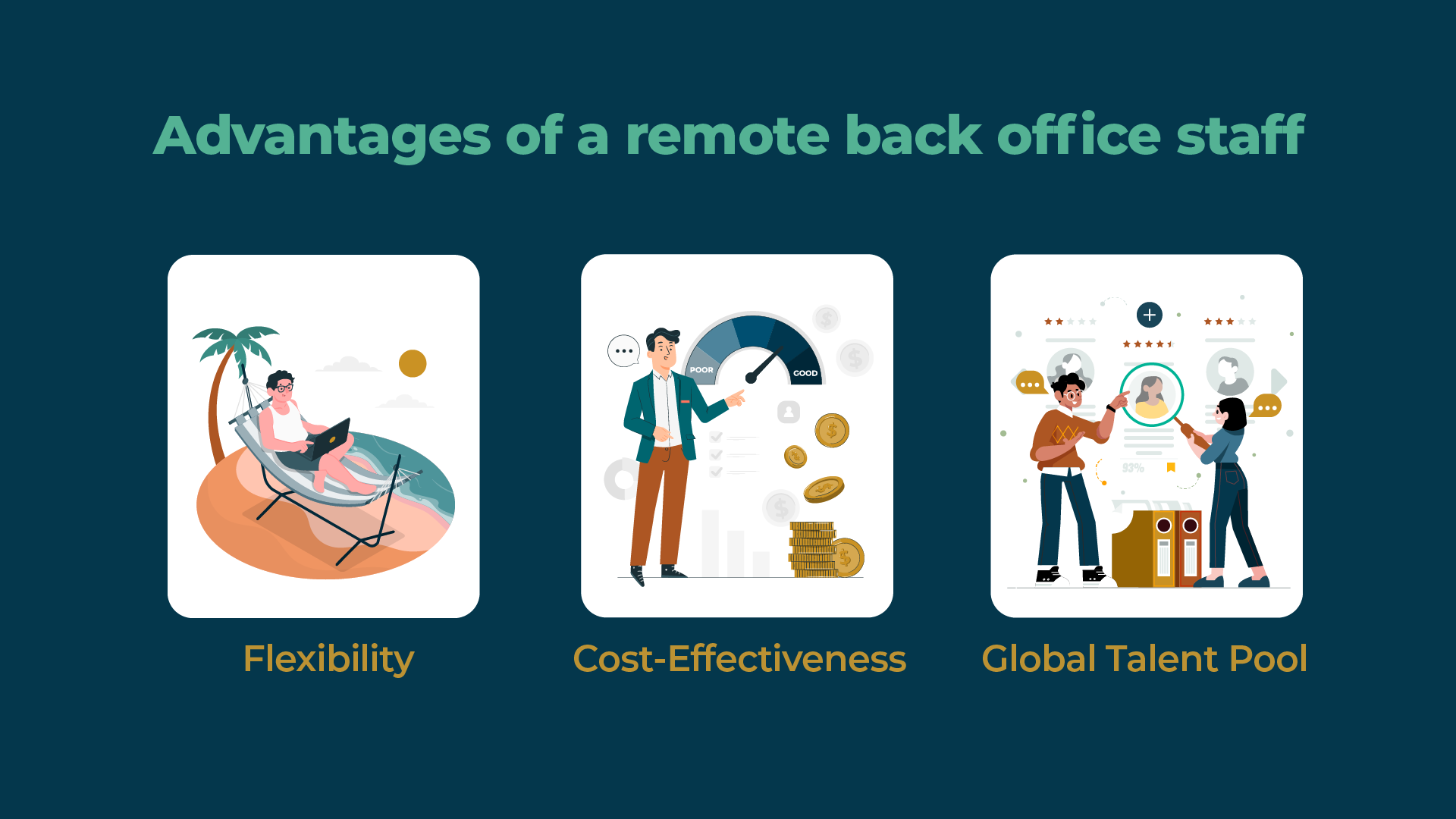
In the bustling world of business, the spotlight often falls on customer-facing activities—sales pitches, marketing campaigns, and client interactions. However, behind the scenes lies a powerhouse that keeps the gears turning: the back office. In this article, we dive into the significance of back-office operations, explore common pain points faced by small and medium businesses, and discuss how the advent of remote work empowers and revolutionizes the way back-offices function.
What Is Back Office?
The back office comprises a variety of critical responsibilities that support an organization’s primary operations. These functions, including administrative tasks, finance, human resources, IT, and procurement, may not be as glamorous as front-facing roles, but they form the indispensable backbone of any successful business.
Importance of Back Office in Business

The back office is the engine that drives the operational efficiency of a business. A well-organized and efficient back office enables firms to focus on their core activities, innovate, and grow sustainably. Below are some of its main purposes:
- Efficiency and Productivity: Back-office operations streamline processes, reduce redundancy, and enhance overall efficiency. When these functions run smoothly, employees can focus on their primary responsibilities, leading to increased productivity.
- Cost Savings: Efficient back-office management translates to cost savings. By optimizing processes, businesses can allocate resources more effectively, minimizing unnecessary expenses.
- Compliance and Risk Management: Back-office teams ensure compliance with legal regulations, financial reporting standards, and data security protocols. Proper risk management prevents costly errors and protects the organization’s reputation.
The back-office personnel are responsible for critical tasks such as payroll processing, compliance management, data analysis, and inventory control.
Although generally thought of as a distinct department within a company, the back office can also relate to certain responsibilities and functions. Let’s look at specific roles and functions in the next part.
Key Functions of Back Office in Businesses

These functions are critical to the smooth operation and success of a business. Here are some primary functions commonly found in the back office.
Financial Management
- Accounts payable and receivable
- Payroll processing
- Revenue management
- Financial reporting
- Tax management
- Governance and compliance
Human Resources
- Hiring and training employees
- Managing benefits
- Resolving internal conflicts
- Maintaining personnel files
Information Technology (IT) Operations
- Database management
- Network Administration
- Programming
- Security engineering
Procurement
- Researching prices for materials, products, and services
- Evaluating suppliers
- Preparing purchase orders
- Monitoring order and contract status
Legal and Compliance
- Developing company policies to comply with laws
- Guarding the company against legal risks
Data Processing
- Data entry, analysis, and management
Common Pain Points in Back Office for Small and Medium Businesses
Despite their critical role, back offices often face challenges:
- Manual Processes: Many small and medium businesses still rely on manual data entry, papers, and spreadsheets. These processes are time-consuming, error-prone, and hinder scalability.
- Lack of Integration: Disconnected systems and siloed departments lead to inefficiencies. Data fragmentation prevents a holistic view of operations.
- Resource Constraints: Smaller businesses struggle with limited resources. Hiring and training staff for back-office functions can strain budgets.
- Automation: Implementing technology-driven solutions automates repetitive tasks, reduces errors, and accelerates processes. Cloud-based software and robotic process automation (RPA) can transform back-office efficiency.
- Integrated Systems: Businesses should integrate their various systems—accounting, HR, inventory management—to create a seamless flow of information. This enables better decision-making and resource allocation.
- Outsourcing, Offshoring, and Remote Staffing: Small and medium businesses can leverage remote work to access skilled professionals without geographical limitations. Outsourcing back-office functions to specialized providers offers cost-effective solutions.
Small and medium businesses often face challenges in managing their back office effectively due to limited resources, expertise, and time constraints. These challenges can hinder growth and competitiveness in today’s dynamic market.
The Role of Remote Work in Back Office Transformation
Working remotely provides a multitude of benefits for companies, especially in back-office positions. Here are a few benefits:

- Flexibility: Remote work allows back-office employees to work from anywhere, promoting work-life balance and attracting top talent.
- Cost-Effectiveness: Hiring remote staff eliminates the need for physical office space, utilities, and commuting costs.
- Global Talent Pool: Companies can access a diversified pool of candidates by hiring remote workers across different time zones and regions.
The back office may operate behind the scenes, but its impact reverberates throughout the organization. By addressing pain points and embracing remote work, businesses can unlock efficiency, cost savings, and resilience in their back-office operations.
Some Back Office Roles for Remote Work
Businesses can use remote work to fill a variety of back-office tasks, providing for greater flexibility and global talent acquisition. Some common remote roles are:
- Remote Administrative Jobs
Data entry, customer service, scheduling, and social media administration are remote admin tasks. These jobs require organization, communication, and technological skills.
- Virtual Back Office Support:
Finance, sales, recruitment, human resources, writing, websites, and social media administration are all examples of virtual back-office support duties. These duties help complete administrative tasks efficiently and cost-effectively.
- Back Office Roles with Impact
Human Resources (HR), Data Entry/Analyst, Accounting & Finance, Financial Analyst, Information Technology, Operations Manager/Director, Offline & Online Security, Compliance Officer, and Employee Experience Manager are all critical back-office responsibilities with a substantial influence. These positions are critical to assisting the front office and ensuring the business runs smoothly.
iSWerk: A Remote Hub in the Philippines

Discover the convenience of remote work with iSWerk: your go-to remote hub in the Philippines. Tailoring solutions to fulfill the back-office needs of businesses, iSWerk boasts a dedicated team of skilled professionals, providing cost-effective remote work options for small and medium enterprises aiming to enhance their back-office operations. The key lies in embracing the transformative potential of remote work, utilizing automation technologies and integrated systems, and outsourcing to specialized providers for efficient operations, minimized errors, and reduced costs.
Partner with iSWerk to gain access to top talent, streamline processes, and achieve substantial cost savings for your business.
Final Thoughts
In conclusion, prioritizing the back-office functions is essential for businesses seeking sustainable growth and success.
Embrace the future of work, prioritize your back-office functions, and advance your company toward long-term growth and success. Discover your organization’s latent potential. Transform your back office with remote work now!
